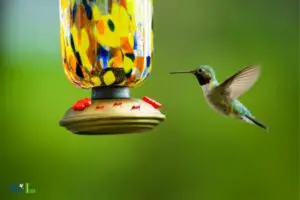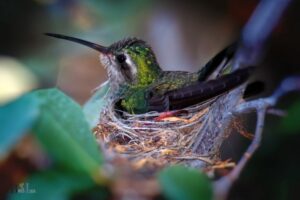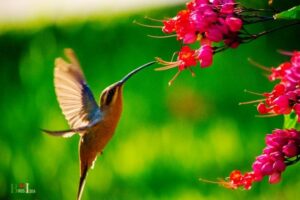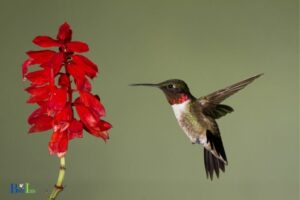How to Deadhead Hummingbird Mint? 7 Steps!
To deadhead hummingbird mint, pinch or snip off spent flower spikes down to the next branch or set of leaves, promoting more blooms and extending the flowering season.
Deadheading is the process of removing spent or faded flowers from plants to encourage new growth, maintain a tidy appearance, and enhance overall plant health.
Hummingbird mint, also known as Agastache, is a popular plant among gardeners for its vibrant flowers, minty fragrance, and ability to attract hummingbirds and butterflies.
Regular deadheading can prolong the blooming season of hummingbird mint, ensuring a continuous display of vivid blooms throughout the summer and fall.
Deadheading hummingbird mint is essential for gardeners who want to make the most of this attractive plant and its attraction to hummingbirds.
By removing the spent flower spikes, you can coax the plant into producing more flowers and extending the blooming season. It also helps maintain a neat garden appearance, adding aesthetic value to your outdoor space.
Regularly deadheading and caring for your hummingbird mint ensures a lush and vibrant garden display throughout the season.
Step-by-Step Guide to Deadhead Hummingbird Mint
| Step | Description |
|---|---|
| 1 | Identify the spent blooms |
| 2 | Choose the right tools |
| 3 | Deadhead before seed formation |
| 4 | Make the cut at the base of the flower stem |
| 5 | Deadhead regularly for continuous blooms |
| 6 | Dispose of deadheaded blooms properly |
| 7 | Monitor plant health after deadheading |
Key Takeaway
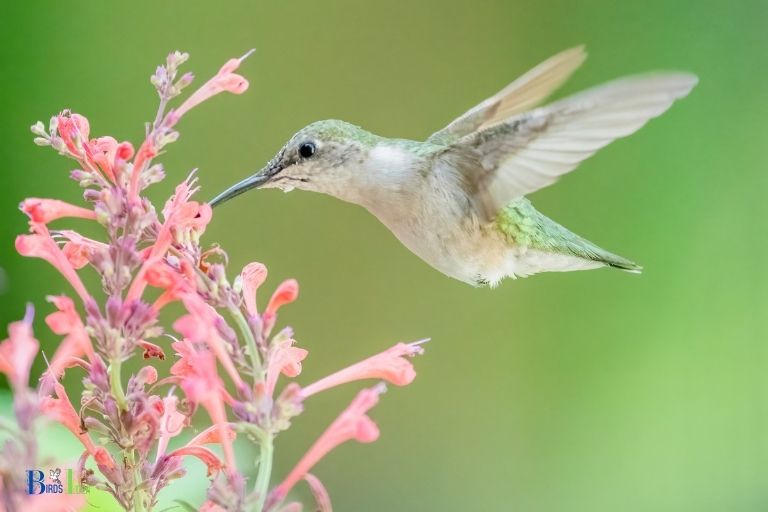
Five Facts About Deadhead Hummingbird Mint
Understanding The Importance Of Deadheading In Hummingbird Mint Care
Why Deadheading Is Important?
Hummingbird mint is a beautiful and vibrant addition to any garden. However, it needs proper care for it to bloom to its fullest potential.
One of the crucial aspects of hummingbird mint care is deadheading. Deadheading is the strategic process of removing the spent or faded flowers from the plants.
It might seem like an unnecessary and time-consuming task, but the benefits it provides to the plant make it a worthy addition to your gardening routine.
Benefits Of Deadheading Hummingbird Mint
Here are some of the benefits that accompany deadheading hummingbird mint:
- Promotes new growth: Deadheading stimulates new growth in the plant. When you remove the faded flowers, it encourages the plant to redirect its energy and nutrients toward producing new blooms, which makes the plant appear fuller and healthier.
- Increases blooming period: Hummingbird mint has a blooming period of around six weeks. However, with deadheading, you can extend this period by encouraging the plant to produce new blooms continuously, which prolongs its beauty and attracts more pollinators to your garden.
- Prevents seed production: If you let the plant produce seeds, it diverts its energy from blooming, which can reduce the amount of blooming that the plant does. Deadheading nips seed production in the bud, ensuring that the plant continues to produce stunning flowers all season long.
- Keeps the garden tidy: By deadheading regularly, you can maintain a garden that’s clean, attractive, and free of wilted flowers. This makes your garden look more presentable and ensures that all visitors can enjoy the beautiful blossoms of your hummingbird mint plants.
Deadheading plays a significant role in maintaining the health, beauty, and longevity of hummingbird mint plants. It’s a simple yet effective technique that can help your garden flourish and attract more exciting pollinators.
By incorporating deadheading into your gardening routine, you’ll be rewarded with vibrant blooms that add color and joy to your outdoor oasis.
When To Deadhead Hummingbird Mint
Identifying The Right Time To Deadhead
Hummingbird mint, also known as agastache, is a popular herb among garden enthusiasts, famous for its unique minty scent.
Deadheading is the process of removing the dead flowers to prolong blooming. Deadheading hummingbird mint is easy, but identifying the right time to do it is crucial.
Here’s how to do it:
- Regular checking – check the plant for dead flowers regularly. Deadheading the flowers as soon as they wilt ensures you can have more blooms throughout the season. It also helps to prevent the plant from going to seed and encourages the growth of healthy foliage.
- Seasonal timing – deadheading at the right time can help regrow an abundant garden season after season. Typically, the best time to deadhead hummingbird mint is after the first wave of blooming is complete. Around mid-summer, cut back the waned flowering stems to one-third of their original height.
- Late season pruning – if you missed the first wave of blooming, don’t worry. Deadheading during late summer will encourage more growth before the plant goes dormant for the season.
Signs When It’S Time To Deadhead
Deadheading is necessary to improve the overall appearance of the plant, extend the blooming period and promote better growth.
If you’re uncertain about whether or not it’s time to deadhead your hummingbird mint, here are some signs that may suggest it’s time:
- Faded flower heads – the most common sign is when the flowers start to fade and wilt. The faded flower heads look dull, and the petals will begin to fall off, revealing the seed pod behind them.
- Browning stems – hummingbird mint flowers grow on spikes, and the stems will start to brown and wither away as the flowers start to die.
- Overgrowth – if the plant becomes unruly and starts to overgrow, deadheading will help promote better foliage growth.
Common Mistakes To Avoid While Deadheading
Deadheading your hummingbird mint will keep it looking healthy and attractive. However, there are common mistakes that most people make while deadheading.
Here are some of them:
- Cutting too low – never cut the entire stem unless it’s dead. Instead, cut the stem above the new growth in the direction where you want the plant to grow in.
- Cutting too high – if you leave too much of the stem, the plant will grow and produce more leaves rather than more flowers, which isn’t the desired result.
- Inconsistent deadheading – deadheading the plant depends on the way it grows, so doing it inconsistently will limit the results. Deadhead on the spike of the stem.
- Over-pruning – over-pruning the plant can result in a slowed blooming process, so it’s best to stick to a regular deadheading habit.
By following these tips and avoiding these common mistakes, your hummingbird mint will keep blooming and looking beautiful throughout the growing season.
Tools And Techniques For Deadheading Hummingbird Mint
Necessary Tools For Deadheading
Before diving into the different ways to deadhead hummingbird mint, it’s essential to equip yourself with the right tools for the job.
Here are some things you’ll need:
- Pruning shears or scissors: For clean, precise cuts, use pruning shears or scissors that are sharp. This will ensure a clean cut, preventing any damage to the plant.
- Gloves: Gloves offer protection, and they also prevent the transfer of disease from plant to plant. Also, they will keep your hands clean.
- Trash bag: Keep a trash bag handy because you don’t want to leave debris around the garden.
Best Practices For Deadheading Technique
Deadheading is a relatively simple task, but a few best practices can make all the difference.
Follow these tips when deadheading hummingbird mint:
- Deadhead often: By deadheading regularly, you’ll encourage the plant to produce more flowers.
- Cut back to the first set of leaves: Cut just above the first set of leaves to encourage branching.
- Remove entire flower stalks: Don’t just remove the dead flowers; remove the entire flower stalk to ensure the plant keeps producing new growth.
- Consider timing: It’s best to deadhead when the weather is dry, and the plant is not under stress.
Different Ways To Deadhead Hummingbird Mint
There are a few different ways to deadhead hummingbird mint, depending on your preference and the size of the plant:
- Pinching: Pinch off the dead flower heads by using your fingers. This method is excellent for smaller plants or individual flowers.
- Cutting: Cut back the stem to the first set of leaves, using your pruning shears. This method is best used for larger stems that have several dead flowers.
- Shearing: Use garden shears or hedge trimmers to cut back the entire plant by a few inches. This method is most suitable for larger plants that have many dead flowers.
By following these tips and techniques, you’ll be able to deadhead your hummingbird mint successfully. Remember, deadheading is essential to promote the plant’s growth and production of flowers.
Steps For Deadheading Hummingbird Mint – A Closer Look
Deadheading hummingbird mint is an essential part of maintenance for this popular plant. This process involves removing the spent flowers, promoting healthy growth and repeat blooming.
In this section, we will take a closer look at how to deadhead hummingbird mint. We will discuss the stepwise instructions for deadheading, pruning basics for healthy growth, and tips for rejuvenating an overgrown plant.
Stepwise Instructions For Deadheading
Deadheading hummingbird mint is a simple process, but it’s essential to do it correctly to ensure healthy growth.
Follow these stepwise instructions for deadheading hummingbird mint:
- Wait until the flowers start to fade.
- Follow the stem down to the first lateral leaf bud.
- Cut the stem using pruning shears right above the lateral bud.
- Repeat the same process for all the flowers that have wilted.
Pruning Basics For Healthy Growth
Besides deadheading, regular pruning is another essential part of maintaining a healthy hummingbird mint plant.
Here are some pruning basics that you should follow:
- Prune the plant in spring to encourage new growth.
- Cut back one-third of the plant’s height to control its size and shape.
- Remove any diseased or damaged stems to keep the plant healthy.
- Prune the plant after flowering to encourage repeat blooming.
Tips For Rejuvenating An Overgrown Plant
Hummingbird mint plants can sometimes become overgrown, which can impact their blooming performance.
But don’t worry, here are some tips for rejuvenating an overgrown hummingbird mint plant:
- Cut the plant back to a third of its size in spring; this will encourage new growth.
- Remove any of the diseased and damaged foliage to prevent disease from spreading.
- Pinch back the tips of new growth throughout the growing season to encourage fullness and bushiness.
- Divide the mature plant every few years to promote healthy growth.
By following these tips, you can promote healthy growth and beautiful blooming of your hummingbird mint plant. And now that you know how to deadhead hummingbird mint correctly, it’s time to get to work!
FAQ On Deadhead Hummingbird Mint
Why Should I Deadhead Hummingbird Mint?
When Should I Deadhead Hummingbird Mint?
How Do I Deadhead Hummingbird Mint?
Can I Deadhead Hummingbird Mint With My Hands?
Will Deadheading Hummingbird Mint Prevent Self-Seeding?
Conclusion
Overall, deadheading hummingbird mint is a simple but important task for any gardener. Not only does it promote healthy growth and a longer blooming season, but it also helps attract pollinators like hummingbirds and butterflies.
The key is to deadhead regularly throughout the season, pinching off spent blooms and preventing the plant from going to seed. With a little practice and patience, you’ll be able to easily identify the old flowers and keep your hummingbird mint looking great all summer long.
Remember to wear gloves and use sharp shears, and to always dispose of spent blooms and debris properly. By incorporating deadheading into your garden routine, you’ll help your hummingbird mint thrive and create a beautiful and welcoming outdoor space. Happy gardening!

